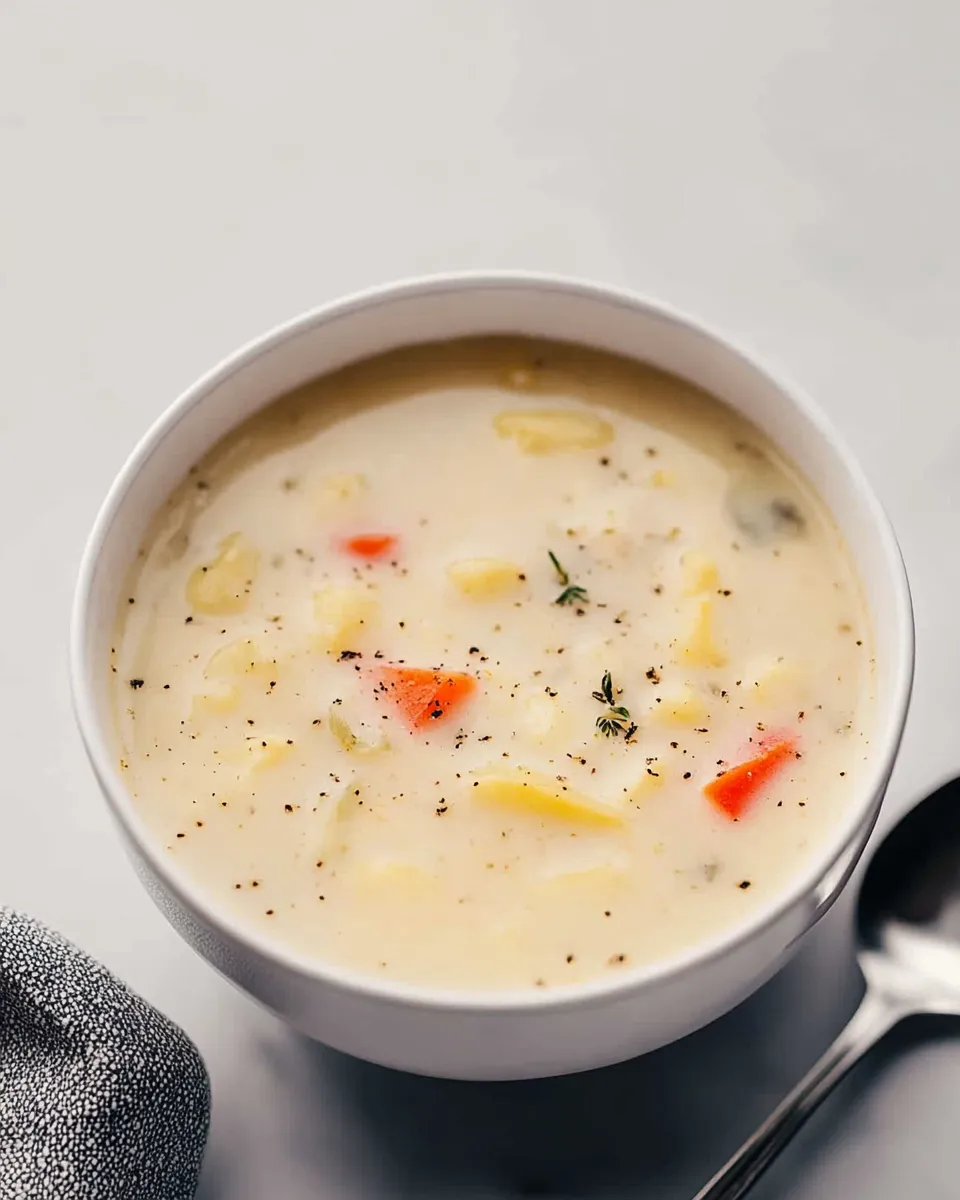Cauliflower Soup: Creamy & Delicious Recipe for All Occasions

Welcome to the comforting world of creamy soups, where one standout dish reigns supreme: cauliflower soup. This versatile creation excels not only as a comforting appetizer but also as a hearty main course. The magic of this dish lies in its delicate flavor profile, which effortlessly marries with a variety of ingredients. Feel free to experiment by adding roasted garlic for depth, blending in some tangy cheddar cheese, or garnishing with vibrant herbs for a pop of color.
To achieve that velvety consistency that sets a great soup apart, consider using a high-speed blender and the freshest produce you can find. Remember, roasting the cauliflower adds an exciting smokiness—a little trick that elevates the dish to a new level. In the following sections, you’ll discover an array of delightful variations and expert tips to make your bowl of bliss truly unforgettable. Get ready to warm your soul with the delightful simplicity of this beloved soup!
Ingredients for Cauliflower Soup:
To create a rich and creamy cauliflower soup that serves 8 to 10 people, you’ll need the following ingredients, carefully selected for optimal flavor and texture. This soup is a comforting choice for any meal, whether it’s a cozy dinner or an elegant gathering.
Base Ingredients:
- 1 large head of cauliflower (about 2-3 pounds), broken into florets
- 2 tablespoons olive oil or unsalted butter
- 1 large onion, chopped
- 3 cloves of garlic, minced
- 4 cups vegetable broth or chicken broth
- 2 cups water
- 1 medium potato, peeled and diced (for added creaminess)
- 1 teaspoon salt (adjust to taste)
- 1/2 teaspoon black pepper (adjust to taste)
Dairy Ingredients:
- 1 cup heavy cream or coconut milk (for a dairy-free option)
- 1/2 cup grated Parmesan cheese (optional, for added richness)
Herbs and Spices:
- 1 teaspoon dried thyme or 1 tablespoon fresh thyme leaves
- 1/2 teaspoon ground nutmeg (optional, for a warm flavor)
- Fresh chives or parsley, chopped (for garnish)
Optional Flavor Variations:
- For a spicy kick, add 1/4 teaspoon cayenne pepper or a chopped jalapeño.
- For a smoky flavor, use smoked paprika instead of regular paprika.
- Consider adding 1 cup of sautéed mushrooms for an earthy twist.
- If you’re looking for a tangy finish, a squeeze of lemon juice can brighten the soup beautifully.
- To make it a meal, incorporate cooked quinoa or lentils for extra protein and texture.
With these carefully curated ingredients, you can whip up a deliciously satisfying bowl of soup that’s not only nourishing but also easy to prepare. Enjoy this versatile dish with bread, crackers, or a fresh salad for a complete dining experience.
How to prepare Cauliflower Soup:
Follow these simple steps to make a delicious and creamy cauliflower soup that is perfect for any occasion.
Gather Your Ingredients
Start by collecting all the necessary ingredients. You will need:
- 1 medium head of cauliflower, chopped
- 1 large onion, diced
- 2 cloves of garlic, minced
- 4 cups of vegetable broth
- 1 cup of heavy cream (or a non-dairy alternative)
- 2 tablespoons of olive oil
- Salt and black pepper, to taste
- Fresh herbs (like parsley), for garnish
Sauté the Aromatics
In a large pot, heat the olive oil over medium heat.
Add the diced onion and sauté until it becomes translucent, about 5 minutes.
Then, stir in the minced garlic and cook for another 1-2 minutes, until fragrant.
Add the Cauliflower
Now, add the chopped cauliflower to the pot.
Stir well to combine it with the onion and garlic. Cook for an additional 5 minutes, allowing the cauliflower to soften slightly.
Pour in the Vegetable Broth
Next, add the vegetable broth to the pot.
Bring the mixture to a boil, then reduce the heat to a simmer.
Cover the pot and let it simmer for about 15-20 minutes, or until the cauliflower is tender.
Blend the Soup
Once the cauliflower is fork-tender, remove the pot from heat.
Use an immersion blender to purée the mixture until smooth and creamy.
If you don’t have an immersion blender, you can transfer the soup in batches to a regular blender; just make sure to let it cool slightly first.
Add Cream and Season
Return the pot to low heat and stir in the heavy cream.
Season the soup with salt and black pepper to taste.
Warm it gently for a few minutes, letting the flavors meld together.
Serve and Garnish
Finally, ladle the soup into bowls.
Garnish with fresh herbs for an extra burst of flavor.
Your creamy soup is now ready to be enjoyed!
Tips for the Perfect Cauliflower Soup
Making a delicious and creamy cauliflower soup requires attention to detail. Follow these tips to ensure great flavor and texture every time.
Maintain the Right Temperature
Start by sautéing the vegetables at medium heat. This method releases their natural sweetness without burning them. If you notice anything starting to catch on the bottom of the pot, reduce the heat. It’s essential to simmer the soup gently once the cauliflower is added to preserve its delicate flavor. Boiling can lead to an undesirable texture, so stick with a covered pot on low heat for best results.
Use Quality Ingredients
High-quality ingredients make a significant difference. Choose fresh cauliflower, which should feel heavy and have compact florets. Organic options not only taste better but may also contain fewer pesticides. Use a homemade or low-sodium vegetable broth for depth. If using store-bought broth, read ingredients to avoid unwanted additives.
Suitable Substitutions for Dietary Restrictions
If you’re cooking for those with dietary restrictions, there are easy substitutions. For a vegan version, use olive oil instead of butter. For creaminess, substitute heavy cream with coconut milk or cashew cream. To make the dish gluten-free, ensure your broth is gluten-free as well.
Enhance Flavor with Add-Ins
Consider adding herbs and spices. Fresh thyme or rosemary can elevate the taste, while a pinch of nutmeg can add warmth. If you like a bit of heat, add crushed red pepper flakes. For a richer flavor, try sautéing garlic and onions before adding in the cauliflower.
Perfect Your Blending Technique
Blending the soup creates a smooth texture. If you have an immersion blender, use it directly in the pot to save time on cleanup. If you use a countertop blender, allow the liquid to cool slightly before blending. Hot liquids can create steam and cause splatters, so fill the blender only halfway and place a kitchen towel over the lid for safety.
Garnishing for Visual Appeal
Don’t forget garnishes! A drizzle of olive oil, a sprinkle of fresh herbs, or some roasted cauliflower florets on top can make your soup look inviting. A few croutons or seeds add a pleasant crunch and extra flavor.
Storage Tips for Cauliflower Soup:
Storing your cauliflower soup properly helps maintain its flavor and texture. Follow these tips for optimal storage.
Cooling Before Storage
Always allow your soup to cool completely before placing it in the refrigerator. Hot soup can raise the temperature inside your fridge, promoting bacterial growth. Pour your soup into shallow containers to expedite cooling. Stir occasionally to help it cool evenly.
Best Containers for Cauliflower Soup
Choose airtight containers for storage. Glass jars or BPA-free plastic containers work well. If you plan to freeze your soup, consider using freezer-safe bags. Leave some space at the top of the container to allow for expansion as the soup freezes.
Refrigeration Tips
Store your cauliflower soup in the refrigerator if you plan to consume it within 3-4 days. Keep the soup on a shelf, away from the fridge door, to maintain a consistent cool temperature. Avoid storing it near foods with strong odors since soups can absorb these.
Freezing Cauliflower Soup for Long-Term Storage
To extend the shelf life beyond a week, freezing is a great option. Portion the soup into individual servings for easy reheating. Label each package with the date to keep track of freshness. Cauliflower soup can last up to 3 months in the freezer without significant loss of taste or texture.
Thawing and Reheating Tips
When ready to use your frozen cauliflower soup, transfer it from the freezer to the refrigerator. Let it thaw overnight for best results. If you’re in a hurry, you can microwave it to defrost. When reheating, do so gradually on the stove, stirring to ensure even heating. Avoid boiling as it can alter the soup’s creamy texture.
Signs of Spoilage
Before consuming leftover soup, check for signs of spoilage. Look for an off smell, discoloration, or any mold growth. If you notice these signs, discard the soup to ensure your safety.
By following these practical storage tips, you can enjoy your cauliflower soup while keeping it fresh and delicious for as long as possible. Proper storage not only maintains the soup’s quality but also minimizes food waste.
Related Recipes to Complement Cauliflower Soup
If you enjoy a comforting bowl of cauliflower soup, you’ll love these similar dishes. They share flavors, textures, and ingredients that enhance your culinary experience.
- Broccoli Cheddar Soup: This creamy soup features fresh broccoli and sharp cheddar cheese. Like cauliflower soup, it offers a smooth, velvety texture and a delightful balance of flavors. Enjoying these soups side by side can create a fun and colorful presentation, celebrating the vibrant greens together.
- Potato Leek Soup: This classic dish blends the earthiness of potatoes and the subtle sweetness of leeks. The creamy base and warming spices make it a comforting choice, similar to the pleasing richness of cauliflower soup. Both soups are also easy to prepare and can be made in large batches for meal prepping.
- Carrot Ginger Soup: This soup brings a bright, vibrant flavor that contrasts nicely with the mildness of cauliflower. The ginger adds a wonderful warmth and kick. Both soups are nutritious and can be served warm or chilled, making them versatile options for various occasions.
- Butternut Squash Soup: This naturally sweet and creamy soup pairs beautifully with the light taste of cauliflower. The sweetness balances the savory notes, offering a perfect harmony of flavors. Like cauliflower soup, it is ideal for showcasing seasonal ingredients and can be garnished with fresh herbs for extra flair.
These related recipes not only highlight the versatility of soups but also provide a variety of delicious options to complement the delightful experience of enjoying a warm bowl of cauliflower soup. Don’t hesitate to experiment and combine different varieties for a flavorful meal!
Frequently Asked Questions:
What is cauliflower soup made of?
Cauliflower soup typically consists of a base of cooked cauliflower, broth, and a variety of seasonings. Some recipes may also incorporate ingredients like onions, garlic, and cream or milk to achieve a smooth, creamy texture. The choice of spices can vary widely, but salt, pepper, and herbs such as thyme or parsley are commonly used to elevate the flavor profile.
Is cauliflower soup healthy?
Yes, this creamy dish is generally considered to be very healthy. Cauliflower is low in calories and boasts a high fiber content, making it a nutritious choice. It’s often vegan and gluten-free, catering to various dietary preferences. Additionally, the vegetable is rich in vitamins C and K, which contribute to overall health.
Can I freeze cauliflower soup?
Absolutely! Cauliflower soup freezes well, especially if it’s made without dairy. To freeze, let it cool completely and transfer it to an airtight container. When you’re ready to enjoy it, simply thaw and reheat on the stove, adding a splash of broth or water if necessary to restore the desired consistency.
How do I make cauliflower soup more flavorful?
To enhance the flavor of your cauliflower soup, consider sautéing onions and garlic before adding the vegetable. Incorporating spices such as cumin or smoked paprika can also impart a richer taste. Furthermore, adding toppings like roasted nuts, croutons, or fresh herbs can bring exciting textures and flavors to the dish.
Can I make cauliflower soup in a slow cooker?
Certainly! A slow cooker can be an excellent way to prepare this vegetable soup. Simply combine chopped cauliflower with broth, onions, garlic, and your chosen seasonings in the slow cooker. Setting it on low for 4-6 hours allows the flavors to meld beautifully, resulting in a rich, comforting soup with minimal effort.
What can I serve with cauliflower soup?
This delightful soup pairs well with various accompaniments. You might enjoy serving it alongside crusty bread, a fresh salad, or grilled cheese sandwiches for a heartier meal. For a unique twist, consider topping it with crispy bacon bits, drizzles of olive oil, or a sprinkle of cheese for added richness and visual appeal.
Conclusion:
In summary, this delicious cauliflower soup stands out for its simplicity and versatility. Using just a handful of ingredients, you can create a creamy, comforting dish that warms the soul and pleases the palate. Remember to experiment with various spices and toppings, as customizing the flavors can elevate your soup to new culinary heights. For added nutrition, consider blending in other vegetables or garnishing with fresh herbs, nuts, or seeds. Whether you prefer it smooth or chunky, this soup serves as a canvas for your creativity in the kitchen. Embrace the flexibility of this recipe, and you’ll find it just as enjoyable to make as it is to savor. With cooking methods that cater to both stovetop and blender fans, this dish truly accommodates any cooking style. Dive into the world of cauliflower soup, and make it your own!







